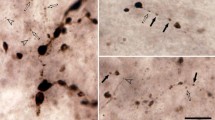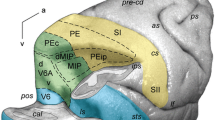Summary
Metal microelectrodes were used to record extracellular potentials from single cells in the four cytoarchitectural areas 3a, 3b, 1 and 2 of the representation of the lower body of the postcentral gyrus of Macaca mulatta monkeys. The animals were paralyzed and artificially respirated while remaining awake. Non-noxious natural stimuli were employed to determine response characteristics, like the submodality, of cells. After recording from a series of normal animals, spinal cord lesions of the dorsal funiculus, were surgically performed at cervical or high thoracic spinal levels. The animals were allowed to recover, and the above-mentioned cell characterization procedures were performed. After the recording, animals were humanely sacrificed and histological reconstructions of the penetrations and the spinal lesions were made. In the postcentral gyrus of normal animals, cells in cytoarchitectural areas 3b and 1 responded predominantly to cutaneous stimuli while cells in areas 3a and 2 responded predominantly to deep stimuli. Responses to displacement of hairs were only recorded in the predominantly cutaneous areas. In these areas in animals with dorsal funiculus transections at cervical or high thoracic spinal cord levels, many fewer cells responded to somatosensory stimulation than in the same areas in normal animals. There were no longer any responses to hair displacement stimuli. In this lower body region, responses to cutaneous stimuli and responses to some deep stimuli were reduced. Cortical areas 3b and 1, that normally showed responses predominantly to cutaneous stimuli, had an increased percentage of responses to deep stimuli. Cells that did not respond to our somatic stimuli but that had a spontaneous firing pattern were found in the first somatic sensory cortex (SI). We conclude that at rostral spinal levels, the dorsal funiculus contains all of the information about hair displacement stimuli of the lower body that projects to the first somatic sensory cortex as well as much information from cutaneous receptors and some from deep receptors on the body surface. Temporal information as well as precise receptive field demarkation is also supplied to SI cells by the dorsal funiculus.
Similar content being viewed by others
References
Andersson SA, Norrsell K, Norrsell U (1972) Spinal pathways projecting to the cerebral first somatosensory area in the monkey. J Physiol (Lond) 225:589–597
Andersson SA, Finger S, Norrsell U (1975) Cerebral units activated by tactil stimuli via a ventral spinal pathway in monkeys. Acta Physiol Scand 93:119–128
Bourne GH (1974) Collected anatomical and physiological data from the rhesus monkey. In: Bourne GH (eds) The rhesus monkey, Vol 1. Anatomy and physiology. Academic Press, New York, pp 3–64
Bowsher D (1965) The anatomophysiological basis of somatosensory discrimination. Int Rev Neurobiol 8:35–75
Brinkman J, Porter R (1972) In: Gordon G (eds) Active touch. Oxford University Press, Oxford, pp 119–138
Brodmann K (1903) Beiträge zur histologischen Lokalisation der Grosshirnrinde. Dritte Mitteilung: die Rindenfelder der niederen Affen. J Psychol Neurol 4:177–226
Brown AG (1973) Ascending and long spinal pathways: dorsal columns, spinocervical tract and spinothalamic tract. In: Iggo A (eds) Handbook of sensory physiology: somatosensory systems, Vol 2. Springer, Berlin pp 315–338
Dreyer DA, Schneider RJ, Metz CB, Whitsel BL (1974) Differential contributions of spinal pathways to body representation in postcentral gyrus of Macaca mulatta. J Neurophysiol 37:119–145
Dubrovsky B, Davelaar E, Garcia-Rill E (1971) The role of dorsal columns in serial order acts. Exp Neurol 33:93–102
Eidelberg E, Kreinick CJ, Langescheid C (1975) On the possible functional role of afferent pathways in skin sensation. Exp Neurol 47:419–432
Hämäläinen HA, Warren S, Gardner EP (1985) Differential sensitivity to airpuffs on human hairy skin. Somatosens Res 2:281–302
Head H (1920) Studies in neurology. Oxford University Press, London
Head H, Sherren J (1905) The consequences of injury to peripheral nerves in man. Brain 28:116–338
Head H, Rivers WHS, Sherren J (1905) The afferent nervous system from a new perspective. Brain 28:99–115
Kalaska J, Pomeranz B (1982) Nerve injuries alter the somatotopic organization of the cuneate nucleus in the kitten. Brain Res 236:35–47
Landry P, Deschênes M (1981) Intracortical arborizations and receptive fields of identified ventrobasal thalamocortical afferents to the primary somatic sensory cortex in the cat. J Comp Neurol 199:345–371
Levitt M, Levitt J (1968) Sensory hindlimb representation in the SmI cortex of the cat after spinal tractotomies. Exp Neurol 22:279–302
Melzack R, Bridges JA (1971) Dorsal column contributions to motor behavior. Exp Neurol 33:53–68
Mountcastle VB (1974) Neural mechanisms in somesthesia. In: Mountcastle VB (eds) Medical physiology, Vol 1. Mosby, St. Louis, pp 307–347
Munger BL (1982) Multiple afferent innervation of primate facial hairs Henry Head and Max von Frey revisited. Brain Res Rev 4:1–43
Munger BL, Halata Z (1983) The sensory innervation of primate facial skin. I. Hairy skin. Brain Res Rev 5:45–80
Perl ER, Whitlock DG (1961) Somatic stimuli exciting spinothalamic projections to thalamic neurons in cat and monkey. Exp Neurol 3:256–296
Pons TP, Garraghty PE, Cusick CG, Kaas JH (1985) the somatotopic organization of area 2 in macaque monkeys. J Comp Neurol 241:445–466
Powell TPS, Mountcastle VB (1959) The cytoarchitecture of the postcentral gyrus of the monkey Macaca mulatta. Bull Johns Hopkins Hosp 105:108–132
Price DD, Mayer DJ (1974) Physiological laminar organization of the dorsal horn of Macaca mulatta. Brain Res 79:321–325
Rice FL, Munger BL (1986) A comparative light microscopic analysis of the sensory innervation of the mystatial pad. II. The common fur between the vibrissae. J Comp Neurol 252:186–205
Schneider RJ (1972) The effects of lesions of the posterior funiculi of Macaca mulatta. Ph. D. thesis. Univ. of Pittsburgh
Schneider RJ, Burke RF (1979) Detection of sub-clinical spinal sensory tract dysfunction. Soc Neurosci Abstr 5:729
Schneider RJ, Burke RF (1980) Detection of spinal sensory tract dysfunction with signal detection theory. Soc Neurosci Abstr 6:727
Schneider RJ, Burke RF (1981) Psychophysical evaluation of somatosensory impairment implicating dorsal (column) funiculus involvement. Soc Neurosci Abstr 7:612
Schneider RJ, Burke R (1982) Hair follicle discrimination dysfunction in multiple sclerosis patients. J Neurol Neurosurg Psychiatr 45:501–506
Schneider RJ, Friedman DP (1983) Hair follicle inputs conveyed to the first somatic sensory area (SI) via the dorsal funiculus are required for the performance of a hair displacement discrimination by rhesus monkey. Soc Neurosci Abstr 9:920
Schneider RJ, Munger BL (1986) Affective-motivational and sensory-discriminative sensations associated with hair stimulation run in separate spinal pathways in monkey. Am Pain Soc Abstr 6:25
Schneider RJ, Kulics AT, Ducker TB (1977) Proprioceptive pathways of the spinal cord. J Neurol Neurosurg Psychiatr 40:417–433
Vierck Jr CJ (1974) Tactile movement detection and discrimination following dorsal column lesions. Exp Brain Res 20:331–346
Vierck Jr CJ, Cohen RH, Cooper BY (1985) Effects of spinal lesions on temporal resolution of cutaneous sensations. Somatosens Res 3:45–56
Vogt C, Vogt O (1919) Allgemeine Ergebnisse unserer Hirnforschung. J Psychol Neurol 25:277–462
Werner G, Whitsel BL (1968) The topology of the body representation in somatosensory area I of primates. J Neurophysiol 31:856–869
Whitsel BL, Petrucelli LM, Sapiro G (1969) Modality representation of the lumbar and cervical fasciculus gracilis of squirrel monkeys. Brain Res 15:67–78
Whitsel BL, Petrucelli LM, Sapiro G, Ha H (1970) Fiber sorting in the fasciculus gracilis of squirrel monkeys. Exp Neurol 29:227–242
Whitsel BL, Dreyer DA, Roppolo JR (1971) Determinants of the body representation in the postcentral gyrus of macaques. J Neurophysiol 34:1018–1034
Whitsel BL, Petrucelli LM, Ha H, Dreyer DA (1972) The resorting of spinal afferents as antecedent to the body representation in the post-central gyrus. Brain Behav Evol 5:303–341
Willis WD, Trevino DL, Coulter JD, Maunz RA (1974) Responses of primate spinothalamic tract neurons to natural stimulation of hindlimb. J Neurophysiol 37:358–372
Author information
Authors and Affiliations
Rights and permissions
About this article
Cite this article
Schneider, R.J. Loss of information concerning hair displacement and other somatic stimuli in the first somatic sensory cortex of unanesthetized Macaca mulatta monkeys following dorsal funiculus transections. Exp Brain Res 83, 105–114 (1990). https://doi.org/10.1007/BF00232198
Received:
Accepted:
Issue Date:
DOI: https://doi.org/10.1007/BF00232198




